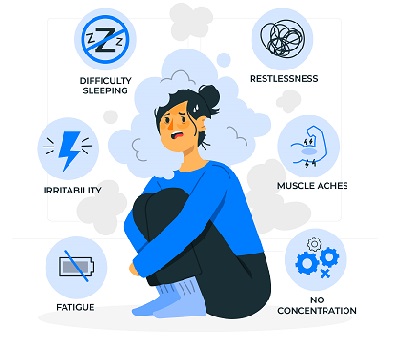- +91 97997 70270
- neuronhospital.rajkot@gmail.com
- 3rd floor, Nana Mava Rd, opposite Saurashtra Children Hospital, Near Rajnagar Chowk, Shyam Nagar, Chandreshnagar, Rajkot, Gujarat 360004
- 24/7 Opened

OCD, or obsessive compulsive disorder, is a crippling and upsetting condition.
The person is unable to stop unpleasant and bothersome thoughts.
People engage in obsessive behavioural patterns, either mental or physical, as a way to cope with these thoughts.
These intrusive thoughts interfere with a person’s everyday routine and make it difficult for them to focus on any task.
The majority of people believe that OCD is merely about unwelcome ideas, and they advise others not to think about it. However, only individuals who are experiencing OCD can truly understand how hard it is to stop these thoughts.
An obsessive thought could be that you have recurring ideas of suicide or homicide over which you have no control, or that certain colours or numbers are “good” or “bad,” or that you have to perform a song for a set period of time.
The individual starts to act compulsively in an attempt to cope with the stress of these obsessive thoughts. For instance, some people spend hours in the bathroom and wash their hands a lot due to their compulsive concerns about contamination.
This helped them feel less anxious for a short while, but their anxiety quickly returned.
Even if you might not wish to think or act in certain ways, you are helpless to stop yourself.
usually observed in young adults and adolescents.
Genes have an impact on OCD. OCD is frequently inherited.
The risk of acquiring OCD is increased if one has an OCD afflicted relative.
Stress can cause OCD symptoms to appear. It is commonly linked to significant life transitions such the death of a loved one, divorce, issues in relationships, challenges in the classroom, or abuse.
Compulsions related to OCD are recurring actions that you feel compelled to carry out.
These repetitive actions or thoughts are an attempt to stop anything negative from happening or to lessen anxiety associated with your obsessions.
But giving in to the compulsions doesn’t make me happy, and it could only provide momentary worry alleviation.
You can establish guidelines or routines to adhere to in order to assist you control your anxiety when you have obsessive thoughts.
Several prevalent compulsions include:
Before performing any task, an OCD sufferer will say specific things, count in specific ways, and perform tasks in specific orders.
An OCD patient might, for instance, use a particular name for a predetermined period of time before eating, or they would count to 10 before drinking water.
For instance, someone may get an insatiable need to read an automobile’s license plate or to multiply and subtract numbers for a predetermined amount of time because they worry that if they don’t, something terrible will happen to them or their family.
compulsion to put an end to bothersome thoughts:
A person with OCD engages in certain rituals to prevent intrusive thoughts.
For instance, someone who constantly thinks about saying terrible things to God might pray at particular times in order to ward off God’s wrath.
For instance, someone with uncontrolled urge to gaze at women’s privates parts or sexual imagination, may avoid public places and engage in multiple acts of masturbation as a coping mechanism.
Some people experience infrequent tics, such as compulsive eye movements and blinking, facial grimacing, shrugging of the shoulders, and jerking of the head or shoulder.
Please get assistance if you are experiencing any such compulsions and are finding it difficult to manage them.
Treatment for OCD is difficult and requires patients’ active participation in order to be effective. Medication and psychotherapy are the two main treatments for OCD. Combining these usually results in the most beneficial course of treatment.
Pharmacotherapy: To treat OCD, medication is usually necessary.
First-line pharmacologic therapies include clomipramine (Anafranil), a tricyclic antidepressant [TCA] with 5-HT and NE reuptake inhibition, and 5-HT reuptake inhibitors, such as the SSRIs (fluoxetine, fluvoxamine, sertraline, paroxetine, citalopram, escitalopram).
Psychotherapy: You can alter your thought patterns with the use of cognitive behavioral therapy.
Your doctor may use exposure and response prevention, which involves placing you in circumstances intended to elicit anxiety or trigger compulsive behaviors. You’ll discover how to decrease and eventually cease your obsessive-compulsive behaviors.
While medication alone is frequently just as effective as behavior therapy (more particularly, exposure with response avoidance), a combination of medication and behavioral therapy is typically the most beneficial course of treatment.
Effective behavior therapy initially destroys the link between the obsessive thinking and the anxiety it causes, and then it breaks the link between carrying out a routine and the subsequent decrease in anxiety.
During exposure therapy, the patient experiences their compulsive thoughts either physically or intellectually. They are then taught how to stop having obsessive reactions to those thoughts.
mental With the help of a qualified and experienced psychotherapist, behaviour therapy is a first-line treatment. At the NEURON clinic, behaviour treatment is provided by our licensed psychologist.
Many OCD patients are not happy with their therapy and are fed up with switching doctors all the time.
At NEURON, we make sure that our patients receive the best care available by carefully listening to their concerns and offering them psychotherapy—which is essential in the treatment of OCD—as well as much-needed psychological support.